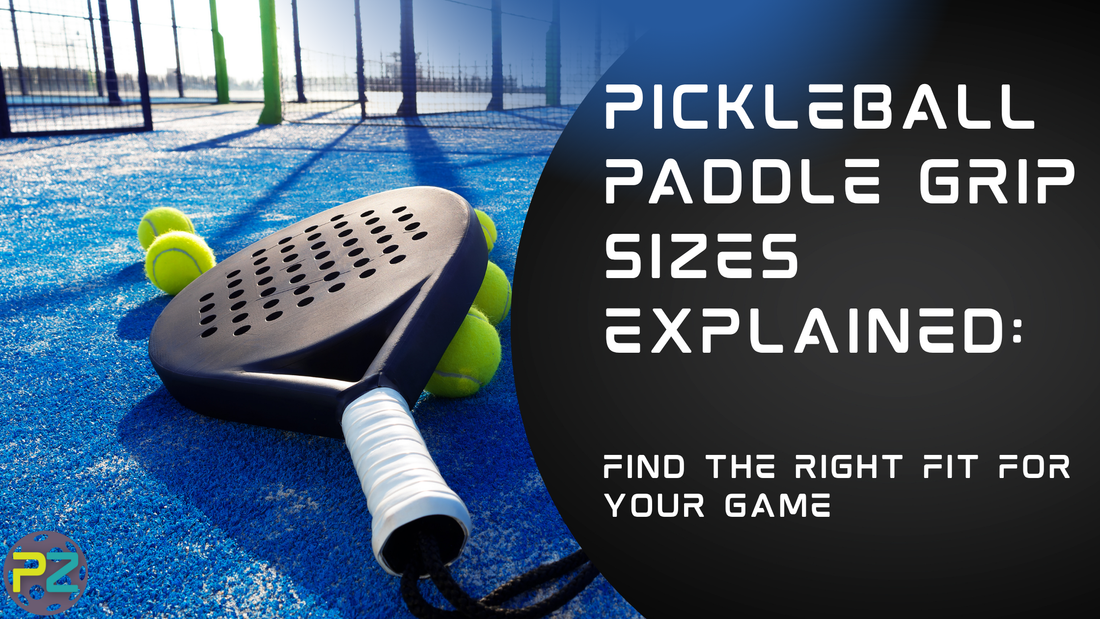
How to Choose the Right Pickleball Paddle Grip Size for Your Hand
Share
Choosing the right grip size on your pickleball paddle can be the difference between playing a strong, confident game and battling discomfort or even injury. For South African players, especially newcomers to the sport, understanding pickleball paddle grip sizes is a critical part of gear selection. This guide will help you figure out what grip size suits your hand, your game style, and your comfort level.
Why Grip Size Matters in Pickleball
Grip size refers to the circumference of your paddle’s handle. If your grip is too small or too large, it can significantly impact your ability to control the paddle. Incorrect sizing can also strain your muscles and joints, potentially leading to repetitive use injuries like tennis elbow.
A properly fitted grip size allows you to maintain a relaxed grip, execute shots with finesse, and play for longer periods without discomfort. South African pickleball players, especially those who play outdoors in hot climates, also benefit from grips that reduce hand fatigue and prevent slippage due to sweat.
Effects of a Poorly Fitted Grip
- Too Small: Forces you to grip tighter, leading to muscle fatigue and a higher chance of overuse injuries.
- Too Large: Limits wrist mobility and makes spin shots more difficult to execute.
How to Measure Your Hand for the Right Pickleball Grip Size
To choose the correct grip size, you can use a simple ruler or test with a paddle. The most reliable method involves measuring your hand:
1. Ruler Method
Place a ruler along your palm, starting from the middle crease at the base of your hand up to the tip of your ring finger. The length in millimetres (mm) indicates your ideal grip circumference.
- 100–105 mm: Small grip – Ideal for juniors and women with smaller hands
- 106–110 mm: Medium grip – Fits most adult players
- 111–115+ mm: Large grip – Suited to those with larger hands or those seeking more stability
2. Index Finger Method
Hold a paddle with your dominant hand using an Eastern grip. Insert the index finger of your non-dominant hand into the space between your fingers and palm. If it fits snugly, the grip is right. If there’s too much room or no room at all, the grip may be incorrect.
Grip Sizes and Playing Style

Your preferred playing style can also guide your grip size choice. Players who rely heavily on wrist action, quick movements, and spin tend to benefit from a slightly smaller grip, which gives them more manoeuvrability. On the other hand, players who focus on power, especially in drives and smashes, may prefer a slightly larger grip to maintain control and reduce torque.
Signs You’re Using the Wrong Grip Size
Sometimes the discomfort or poor performance you’re experiencing may be linked directly to grip size. Look out for the following signs:
- Consistent wrist, forearm, or elbow discomfort after games
- Blisters or calluses on the palm or fingers
- Loss of paddle control during extended rallies
- Wrist stiffness after long practice sessions
Can You Modify a Paddle’s Grip Size?

Yes! Grip size isn’t permanent and can be adjusted with accessories:
Overgrips
Overgrips are thin wraps that add approximately 1–2 mm to your existing grip. They also improve tackiness and sweat absorption, essential for long summer games in Gauteng or Durban. They can also provide a bit of extra padding, which makes play more comfortable over time.
Replacement Grips
Thicker than overgrips, these replace the original grip and can add 2–4 mm to your paddle’s handle. They offer better cushioning and are ideal for players with grip-related joint issues. Look for ones made of polymer or tacky rubberised materials for a longer-lasting solution.
What Else Affects Grip Feel?
It’s not just circumference that affects how a grip feels in your hand. Materials and texture also matter. Some players prefer cushioned grips with ribbed patterns for a more tactile connection to the paddle, while others opt for smooth grips that allow quick repositioning during play. In humid South African regions, grips with anti-slip finishes or moisture-wicking technology are especially useful.

Joola Paddle Designs: Ergonomics Meets Performance
At Pickleball Zone South Africa, we’re proud to supply Joola Pickleball paddles, known for their cutting-edge designs and ergonomics. Whether you’re buying your first paddle or upgrading, Joola models feature contoured handles and a wide range of grip sizes for South African players of all hand sizes.
Joola’s innovations include grip technology that reduces vibration and absorbs shock, which is crucial for injury prevention. Their handles are constructed with cushioned polymer layers, offering a soft yet secure hold without compromising on responsiveness or control.
Preventing Injuries with the Right Grip
Medical professionals agree that the correct grip size helps prevent repetitive stress injuries. According to the American Academy of Orthopaedic Surgeons, athletes using improper grips are more prone to conditions such as epicondylitis (tennis elbow) and wrist tendonitis. South African players who train regularly should pay special attention to grip ergonomics as part of their injury prevention routine.
Real Experiences from Local Players
Johannesburg-based player Lerato M. shares: “Switching to a smaller grip totally changed my game. I now feel more in control of my dinks and backhand flicks.” Similarly, Pietermaritzburg’s Michael D. says: “My tennis elbow vanished once I found a grip that suited my hand size. I’m grateful for the overgrip suggestion I got from Pickleball Zone SA.”
FAQs About Pickleball Paddle Grip Sizes
-
Q: Can I play with a grip that’s slightly too small?
A: Yes, it’s better to start small and build up using overgrips than to start with a grip that’s too large. -
Q: How often should I replace my paddle grip?
A: Replace overgrips every 20–30 hours of play or when they feel worn or slippery. Main grips can last longer but inspect them monthly. -
Q: Does climate affect grip performance?
A: Absolutely. In humid or sweaty conditions, textured or perforated grips offer better traction.
Internal Resources to Help You Choose
- Explore different grip sizes via our Pickleball Paddle Collection.
- Check out hand grips and wraps in our Accessories Collection.
External Learning: Injury Prevention Tips
To go beyond equipment and learn how to keep your wrists and elbows healthy, browse injury guides and tips at OrthoInfo by AAOS.
Final Thoughts: Your Ideal Grip Is Within Reach
Understanding pickleball paddle grip sizes isn’t just about numbers — it’s about playing your best game. A correctly sized grip enhances your performance, ensures long-term comfort, and helps prevent injury. Whether you’re just starting or fine-tuning your competitive edge, the right grip is a foundational part of your pickleball experience.
Visit Pickleball Zone SA to explore Joola paddles built for players of all sizes and styles. Let us help you find a grip that fits — and wins.
